For most of my life, I have been confused and fascinated by “Baby On Board” bumper stickers. My primary concern is this: If you do not, in fact, have a baby on board, is it then okay to crash into you? No? Then isn’t the sticker a little redundant?
I suppose I can forgive the existence of these stickers since they are well-intentioned – they mean to remind people to drive safely. I’m okay with that. However, every day when I get to work, I park next to a car which has two crown-shaped bumper stickers.
The blue: “King on Route.”
The pink: “Princess on Route.”
I’m sorry, I have to ask. Assuming that these do not refer to legitimate royalty, why does your son get to be King and your daughter is a mere Princess? That was obviously a deliberate marketing decision made by someone, somewhere. Do we not like the word ‘prince’? Or, worse, do we mistrust the word ‘queen’?
Or… are we using the traditional patriarchal monarchy in which your son is the Crown Prince (still not King, but anyway) and therefore your daughter will be Princess for life because she’s not entitled to rule unless your son dies with no heirs?
Gotta say, since this isn’s a real monarchy (again I’m making an assumption, but if these people really are royalty, why do they work in the same building as me?) why can’t you stretch reality just a tad further and make your daughter a Queen?
Thus, every morning, I am reminded about Princesses and all the rules and regulations that come with being one. And this is where I’ll begin.
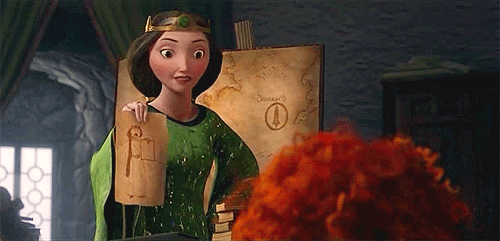
A Princess Is a Role Model
I’m the princess. I’m the example. I’ve got duties, responsibilities, expectations. My whole life is planned out, until the day I become, well, my mother. She’s in charge of every single day of my life.
The requirement for Princesses to be Role Models goes beyond the lessons Merida gets from her mother in Brave. Indeed, when Brave was released, we were inundated with criticism about Merida and her suitability as a role model for girls. Clearly, these people either didn’t watch the movie or just completely, embarrassingly, missed the point. But I digress: Today is about Disney.
While Disney certainly relies on traditional female narratives more than it should, it is also not afraid to unpack those narratives. As the Disney Renaissance rolled around, we saw princesses begin to participate in their stories, and Disney began to provide some gentle commentary on the patterns we tend to see in our female characters.
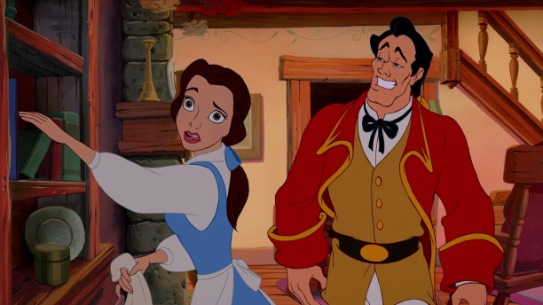
We’ve said it before, and we’ll say it again: Gaston is the best thing about this movie. He, and the way Belle reacts to him, hit way too close to home.
While Ariel pursues a dream of her own, and Jasmine plays a side-role in someone else’s adventure, Belle’s story has the most poignant animate metaphor ever for all Patriarchy who marches into her house and tells her that she’ll be marrying him. And as we all have at some point or another, Belle rolls her eyes and then tricks him into leaving her house so she can get on with her life.
Four years later, this happened:
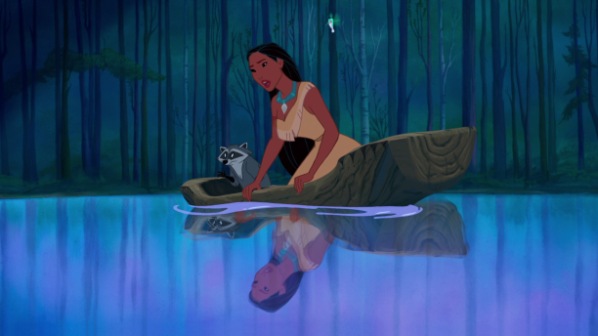
Pocahontas, like Belle, is faced with a traditional narrative: Marry the man who we’ve deemed good enough for you. In fact, Pocahontas’ narrative is a little less on-the-nose than Belle’s, because her father is in on it – and because Kocoum seems to be perfectly nice, if serious. Despite this movie’s (many) flaws, it opened the Disney Door to the idea that even if a man is decent and good looking and your dad likes him, a woman might not want to bone him. HMMMMMM IMAGINE THAT. #friendzoned.
Sorry.
Now, this isn’t groundbreaking stuff. These are tropes in themselves that belong to many female characters outside of the Disney and Fairy Tale realm, where they don’t go for the one guy and instead go for the other guy (see: every Romantic Comedy ever). So let’s get into the real deep-fried tofu of the discussion with my three personal favourites.
Mulan and the Female Narrative
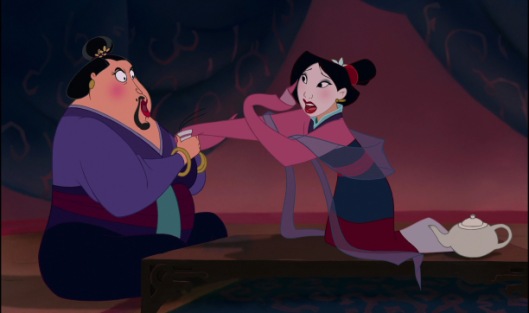
There she is. You knew it was coming.
Mulan is a movie centered entirely around an extremely strict cultural narrative for women, referenced again and again in song, dialogue, and imagery like this:
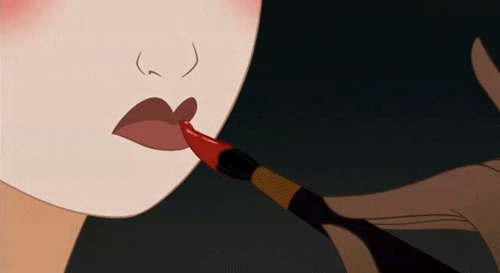
Literally painting her face to look like “a perfect porcelain doll”. There’s a reason why every complaint about women in Disney ends in “except Mulan”. Also, I could watch this GIF all day. I wish I had those liquid eyeliner skills.
Self-image, or “reflection”, is one symbol the movie uses to not-so-subtly talk about the female narrative and how it doesn’t quite suit all of us. While Belle and Pocahontas lamented being expected to marry men they weren’t really into, Mulan didn’t even mention the that they were attempting to marry her off – she sings about the fact that her personality is at odds with the role she is expected to play as a woman, wife, and daughter.
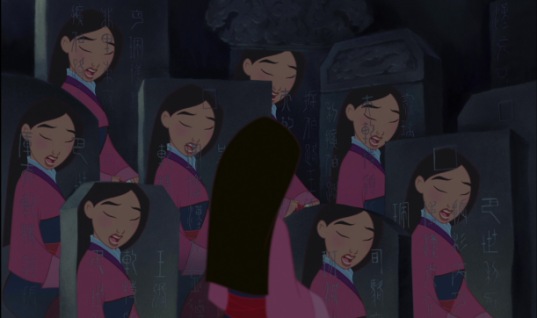
The crux of this issue, of course, is that being who she is would “break [her] family’s heart”. While it’s clear that she feels conflicted about who and what to be at this stage in her life, the choice is taken away from her when her father is summoned back to the army – now that she has to save her father’s life, she grasps the opportunity to escape as an added bonus.
That reflection imagery comes back when Mulan goes to chop her hair off, in this genius sequence which is only more genius with soundtrack:
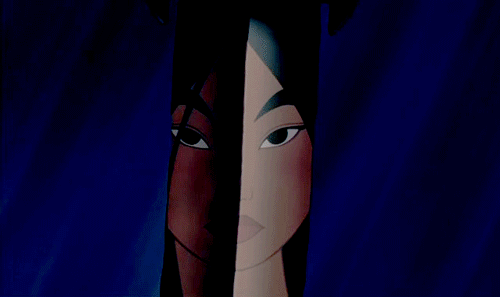
Thus, Mulan solidifies her commitment to rejecting her cultural narrative, while taking one last look at her own face in the reflection of her father’s sword. Symbolism.
Tiana and the Female Narrative
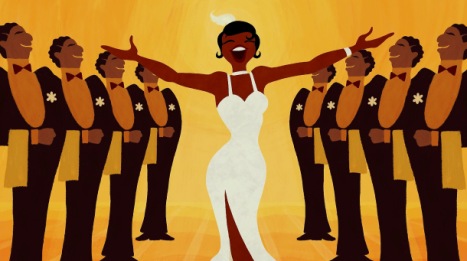
We discussed this one recently, touching on how Tiana rejects the idea of fairy tales and wants to gain everything through hard work. We can read this through a feminist lens as well. Shall we?
The traditional female narrative we like to criticize Disney for involves ladies like Cinderella sitting pretty while the plot happens around them. Some ladies, like Belle and Mulan, get dragged into adventure because they have to save their fathers, and in doing so manage to become self-actualized. But they didn’t do it on their own – they were compelled by circumstance.
None of this applies to Tiana. She goes out and gets what she wants.
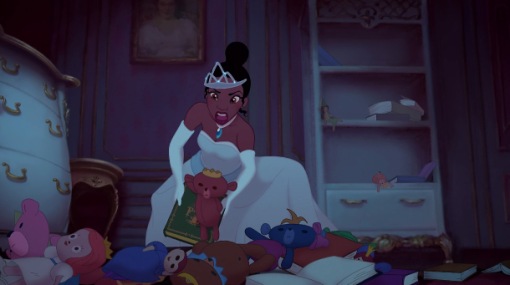
If anything, circumstance only slows her down. Between froggy princes and racist realtors, it seems like everything is working against Tiana and her restaurant.
The role that Tiana plays in her fairy tale is a role often held by a man.
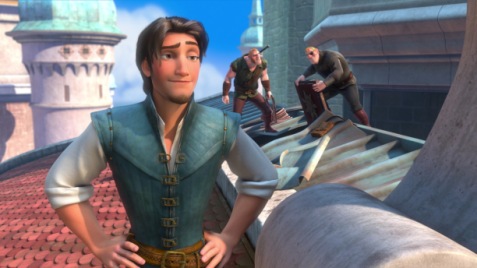
Like this man, for example.
Tangled is a traditional story of optimism VS cynicism, in which optimism wins out because Disney and also because Children’s Lit. We have our beautiful, virtuous, wide-eyed optimist Princess, and then we have Flynn Rider, who is just too good for all of this fairy tale stuff.
The new renaissance princess of The Princess and the Frog is probably this lady:
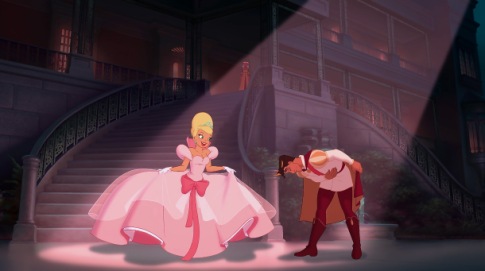
Tiana is held in stark contrast to Lotte throughout the film:
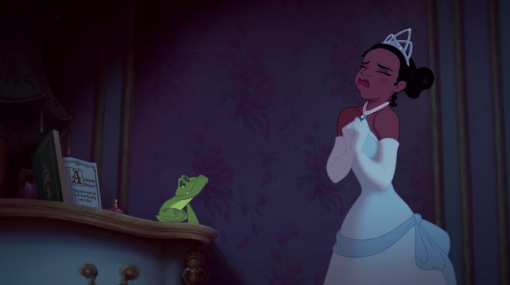
Tiana is no Flynn Rider, but she is definitely too good for this fairy tale nonsense. The movie sets out to prove her wrong about love and magic and fairy tales, and in doing so, it completely turns Disney stereotypes on their heads.
Elsa, Anna, and the Female Narrative
Here’s another movie that deliberately set out to deconstruct female narratives.
Let’s talk about Anna first.
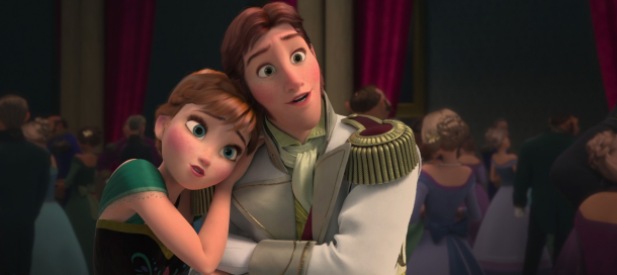
So Anna is supposed to be the traditional princess in this movie. She checks all the boxes – cooped up with no social life to speak of, gets compelled to go on an adventure to save someone else, falls in love immediately and decides to get married right away… Every part of her story mimics the Renaissance princesses.
Until:
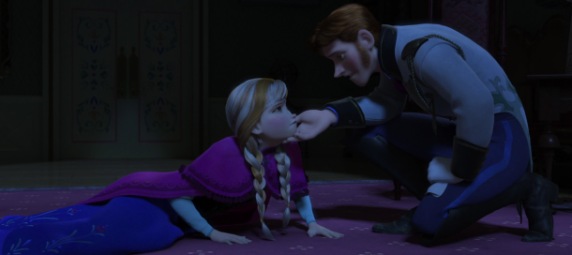
*Glass shatters* This isn’t a Renaissance movie, folks.
Now, I think we all saw the Anna/Kristoff thing coming, so I doubt many of us were shocked by this reveal. However, it was the first time in any Disney film that a Princess has it wrong about her Prince. Until now, we’ve been very reverent toward the idea of true love, but Frozen argues that it’s a little more complicated than that.
But this isn’t about love, it’s about women. So what does Anna tell us about women in Disney?
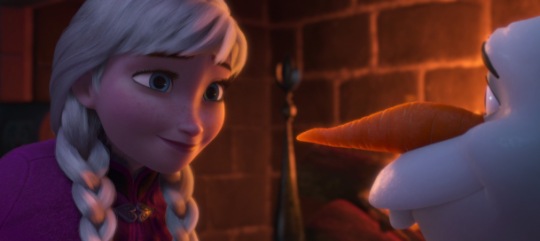
From the beginning, this was a movie about sisters in particular, but Olaf’s love for Anna makes an important point: Love isn’t all princes and princesses. Sometimes it’s family. Sometimes it’s animals. Sometimes it’s snowmen. And all of it has power. In other words – the romantic story arc for women is not all we’re good for. Women have plenty of other stories to tell:
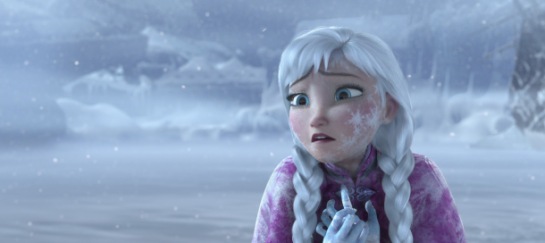
Like when we throw ourselves in front of a sword to save our sisters.
Elsa is a whole other thing. First of all, is she the first Disney Queen? She is, right? I mean, the first Disney Queen who isn’t a villain.
So she’s got that going for her. She’s also got a bit of a Mulan thing going on, except where Mulan is bad at being ladylike, Elsa is bad at not killing everyone around her with her ice powers. She knows that if she were honest about who and what she is, she would be letting an entire kingdom down. She puts a tremendous amount of pressure on herself to keep everything as it should be.
And then:
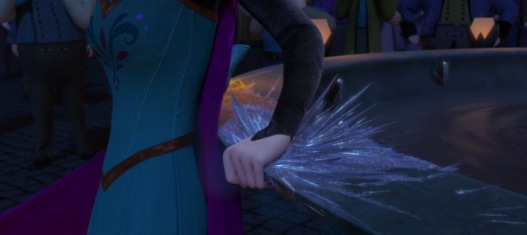
Although this isn’t exactly Elsa’s fault, she has to flee the kingdom after her coronation for reasons that belong to no one but herself: It’s time to start facing the reality of who she is. She can no longer hide from it. Unlike Belle, Mulan, and Tiana, who are forced onto their journeys due to arbitrary and unfair circumstances (Belle: Father kidnapped and locked in a dungeon to die for LITERALLY NO REASON. Mulan: Conscription and lack of brothers compelled her elderly and disabled father to go back to war which makes NO SENSE. Tiana: “A little woman of your… background“. SIGH.), Elsa is the sole driving force of her own plot conflict. Cool!
To sum up, what I have to say is this: Although we women-types have a long way to go in this and all other forms of media (as well as in real life), it’s important to seek out positive feminist messages in the things that girls actually like. Not that all girls like princesses. But when we do, maybe take us seriously. Why do we like them? What do we like about them? Why does dressing up as princesses give girls so much empowerment? Why do girls get so much joy from singing I Want Songs?
On a related note: The next thing you’ll be hearing from me is my (doomed to failure) argument that Let it Go is an empowering song. WISH ME LUCK.
Best regards,
three




Another tremendous piece. Balanced, thoughtful, thought-provoking.
It’s interesting you open with the bumper stickers story as I had a somewhat similar experience at a Star Trek convention I went to recently. I saw a young girl there wearing a t-shirt reading: “I want to be a starship engineer, not a Princess.” It was a fun little shirt, but it struck me as a little sad. What’s the problem with being a princess? Why does this little girl have to choose one or the other? Can she not be an engineer who likes girly things like princesses?
I think as a culture we’ve framed what it means to be a Princess in the wrong way, and Disney is to blame for that to some degree. The way they market the Princesses trades heavily on their beauty; just look at the way Merida’s wild hair and curvy features have been ironed out to be more ‘traditionally’ pretty in the marketing. The marketing simply reaffirms the idea that Princesses are bad role models, which makes people wary of them.
What I love about this piece is that it asks the most important question, and the most feminist question: girls like these characters, so… why? It seems to me to be an act of sexism (well-intentioned though it may be) to tell girls they shouldn’t be Princesses. Surely they can and should be whatever they want: if that’s dressing in oil stained clothes to be an engineer that’s great. If it’s dressing in pretty gowns and being a Princess, that’s fine too.
We need to understand why these characters are so beloved by girls, because if we really think it’s just because they have nice clothes and voices, then I’d say that’s more destructive and more sexist than anything the Princesses themselves are saying.